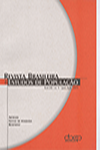The relationship between childbirth and women’s labor in Brazil
Keywords:
Fecundity, Job supply, Women, BrazilAbstract
The objective here is to analyze the effect of having children on women’s share in the economically active population, observing the temporal evolution of this effect during the 1990s. In addition, based on the fact that each child may exert a different effect on a mother’s decision to work or not, the effect of the first, the second and the third (or more) children on this woman’s share in the economically active population were estimated. In general the findings suggest that, regardless of order of birth, children reduce the likelihood of women to participate in the labor market. Also, during the 1990s and the decade of 2000 the negative effect of the first and second children on women’s share in the labor market fell in impact, whereas the effect of a third child took on some importance.Downloads
Downloads
Published
How to Cite
Issue
Section
License
Papers published in Rebep are original and protected under the Creative Commons attribution-type license (CC-BY). This license allows you to reuse publications in whole or in part for any purpose, free of charge, even for commercial purposes. Any person or institution can copy, distribute or reuse the content, as long as the author and the original source are properly mentioned.

